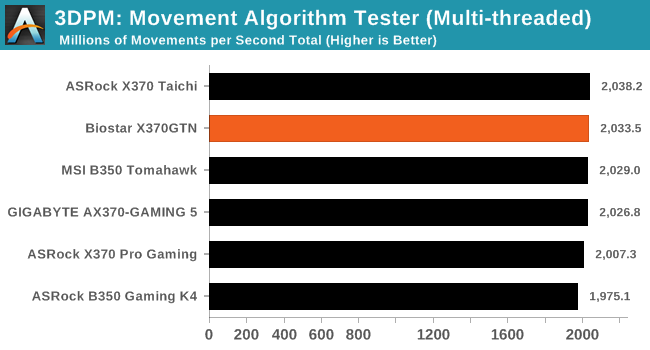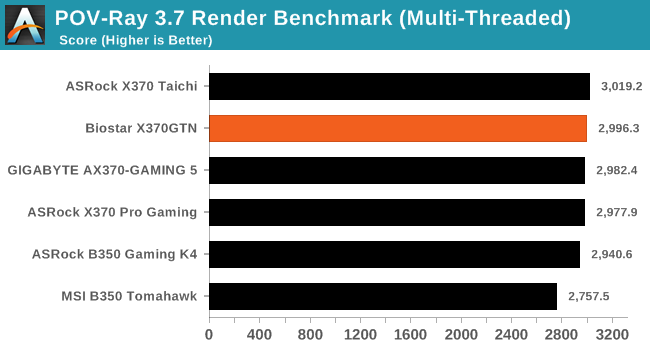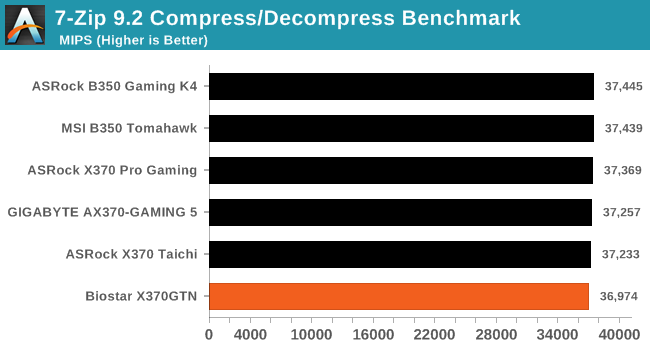The Biostar X370GTN Mini-ITX Motherboard Review: AM4 Goes Tiny
by Gavin Bonshor on October 23, 2017 9:00 AM ESTCPU Performance, Short Form
For our motherboard reviews, we use our short form testing method. These tests usually focus on if a motherboard is using MultiCore Turbo (the feature used to have maximum turbo on at all times, giving a frequency advantage), or if there are slight gains to be had from tweaking the firmware. We put the memory settings at the CPU manufacturers suggested frequency, making it very easy to see which motherboards have MCT enabled by default.
Video Conversion – Handbrake v1.0.2: link
Handbrake is a media conversion tool that was initially designed to help DVD ISOs and Video CDs into more common video formats. For HandBrake, we take two videos and convert them to x264 format in an MP4 container: a 2h20 640x266 DVD rip and a 10min double UHD 3840x4320 animation short. We also take the third video and transcode it to HEVC. Results are given in terms of the frames per second processed, and HandBrake uses as many threads as possible.



Compression – WinRAR 5.4: link
Our WinRAR test from 2013 is updated to the latest version of WinRAR at the start of 2017. We compress a set of 2867 files across 320 folders totaling 1.52 GB in size – 95% of these files are small typical website files, and the rest (90% of the size) are small 30 second 720p videos.

Point Calculations – 3D Movement Algorithm Test v2.1: link
3DPM is a self-penned benchmark, taking basic 3D movement algorithms used in Brownian Motion simulations and testing them for speed. High floating point performance, MHz and IPC wins in the single thread version, whereas the multithread version has to handle the threads and loves more cores. For a brief explanation of the platform agnostic coding behind this benchmark, see my forum post here. We are using the latest version of 3DPM, which has a significant number of tweaks over the original version to avoid issues with cache management and speeding up some of the algorithms.

Rendering – POV-Ray 3.7.1b4: link
The Persistence of Vision Ray Tracer, or POV-Ray, is a freeware package for as the name suggests, ray tracing. It is a pure renderer, rather than modeling software, but the latest beta version contains a handy benchmark for stressing all processing threads on a platform. We have been using this test in motherboard reviews to test memory stability at various CPU speeds to good effect – if it passes the test, the IMC in the CPU is stable for a given CPU speed. As a CPU test, it runs for approximately 2-3 minutes on high end platforms.

Synthetic – 7-Zip 9.2: link
As an open source compression tool, 7-Zip is a popular tool for making sets of files easier to handle and transfer. The software offers up its own benchmark, to which we report the result.

Neuron Simulation - DigiCortex v1.20: link
The newest benchmark in our suite is DigiCortex, a simulation of biologically plausible neural network circuits, and simulates activity of neurons and synapses. DigiCortex relies heavily on a mix of DRAM speed and computational throughput, indicating that systems which apply memory profiles properly should benefit and those that play fast and loose with overclocking settings might get some extra speed up. Results are taken during the steady state period in a 32k neuron simulation, and represented as a function of the ability to simulate in real time (1.000x equals real-time).










31 Comments
View All Comments
Brother Ali - Thursday, October 26, 2017 - link
I have the asrock itx B350 and a 1600. I have my voltage set to 1.375 in the bios. In HWMonitor its .384V-1.392V; stays at 1.392V consistently.austinsguitar - Wednesday, October 25, 2017 - link
this sort of thing is why itx is bad for high wattage components. you cant expect much from this gigabyte board. the cooling on the vrm is awful. horindusly bad. these motherboards should not be overclocked too high for the long run. if you look up guides on the design of them they all miss the mark in components and cooling. so all in all. mini itx, dont do it on ryzen. atleast for overclocking long term. your problem is not new.xrror - Wednesday, October 25, 2017 - link
This is a Biostar board, not Gigabyte.Dr. Swag - Monday, October 23, 2017 - link
It would be great to see a better look into the vrms (efficiency, mosfet temps, etc.). AM4 VRMs seem to have been a hot topic (pun intended) since Ryzen launched due to boards with pretty budget vrms being able to run with 8 core CPUs. I would like a more in depth look into the vrms of each board to see how worthy all of them are.u.of.ipod - Monday, October 23, 2017 - link
Always happy to see small form factor reviews!!!Lurpak - Monday, October 23, 2017 - link
I have had this motherboard for since June and to be honest, I can not recommend it. If you are running an old version of the BIOS the motherboard is so unstable that it crashes all the time. My first unit died on me during a BIOS update (there's no backup BIOS), but luckily I was able to update the BIOS on the second one.Currently my problems are with memory where the motherboard sometimes fail to boot at XMP settings, which then requires me to set them again and hope that it works. My memory problems could be down to AGESA and seems to have been more stable since I got a BIOS update with AGESA 1.0.0.6b, but it still fails once in a while.
twnznz - Tuesday, October 24, 2017 - link
Does yours power cycle 5x when it fails a boot as well? I'm rolling AGESA 1.0.0.6b as well, Trident Z F4-3200C14D-16GTZR 14-14-14-34, with XMP settings. I've wound the mem voltage up to meet 1.35vLurpak - Tuesday, October 24, 2017 - link
Yeah, that is exactly what it does. The 5 times power cycle is a fail-safe designed to catch errors in BIOS settings. From what I have read the problem with the board seems to be, that it cannot get the correct voltage for the RAM and therefore fails boot. I am running G.Skill Ripjaws V, which runs at higher latencies.Paull29724 - Sunday, November 19, 2017 - link
I just got this motherboard, whats your system config?jrs77 - Monday, October 23, 2017 - link
mITX-boards are allways nice, but without an APU a mITX-board is pretty much useless for the majority of people, who would want to build a silent and powerefficient HTPC or SFF-office station with these.